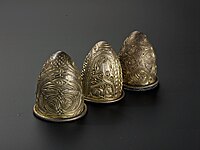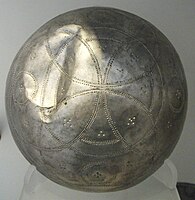St Ninian's Isle is a small tied island connected by the largest tombolo in the UK to the south-western coast of the Mainland, Shetland, in Scotland. It is part of the civil parish of Dunrossness on the South Mainland. The tombolo, known locally as an ayre from the Old Norse for "gravel bank", is 500 metres long. During the summer the tombolo is above sea level and accessible to walkers. During winter, stronger wave action removes sand from the beach so that it is usually covered at high tide, and occasionally throughout the tidal cycle, until the sand is returned the following spring. Depending on the definition used, St. Ninian's is thus either an island, or a peninsula; it has an area of about 72 hectares.
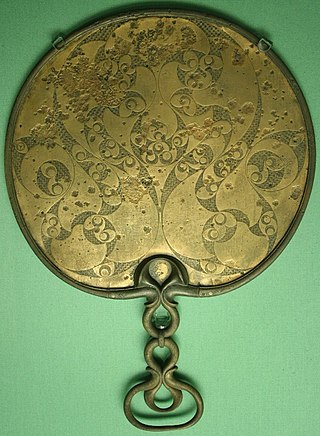
Celtic art is associated with the peoples known as Celts; those who spoke the Celtic languages in Europe from pre-history through to the modern period, as well as the art of ancient peoples whose language is uncertain, but have cultural and stylistic similarities with speakers of Celtic languages.

Migration Period art denotes the artwork of the Germanic peoples during the Migration period. It includes the Migration art of the Germanic tribes on the continent, as well the start of the Insular art or Hiberno-Saxon art of the Anglo-Saxon and Celtic fusion in Britain and Ireland. It covers many different styles of art including the polychrome style and the animal style. After Christianization, Migration Period art developed into various schools of Early Medieval art in Western Europe which are normally classified by region, such as Anglo-Saxon art and Carolingian art, before the continent-wide styles of Romanesque art and finally Gothic art developed.

The quoit brooch is a type of Anglo-Saxon brooch found from the 5th century and later during the Anglo-Saxon settlement of Britain that has given its name to the Quoit Brooch Style to embrace all types of Anglo-Saxon metalwork in the decorative style typical of the finest brooches. The brooches take their modern name from the rings thrown in the game of quoits, and have the form of a broad ring, or circle with an empty centre, usually in bronze or silver, and often highly decorated. The forms are in a very low relief, so contrasting with other early Anglo-Saxon styles, with detail added by shallow engraving or punching within the main shapes. Dots or dashes are often used to represent fur on the animal forms, as well as lines emphasizing parts of the body. They are fixed with a single, straight hinged pin like those of other Anglo-Saxon ring or Celtic brooches and are further defined by the presence of a slot and pin-stops on the ring.

Chape has had various meanings in English, but the predominant one is a protective fitting at the bottom of a scabbard or sheath for a sword or dagger. Historic blade weapons often had leather scabbards with metal fittings at either end, sometimes decorated. These are generally either in some sort of U shape, protecting the edges only, or a pocket shape covering the sides of the scabbard as well. The reinforced end of a single-piece metal scabbard can also be called the chape.
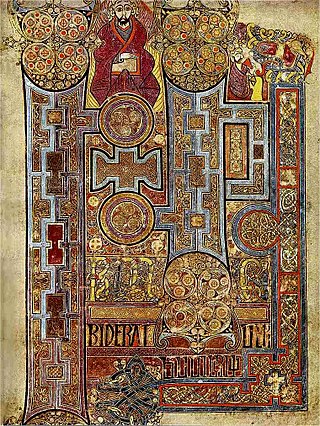
Insular art, also known as Hiberno-Saxon art, was produced in the post-Roman era of Great Britain and Ireland. The term derives from insula, the Latin term for "island"; in this period Britain and Ireland shared a largely common style different from that of the rest of Europe. Art historians usually group Insular art as part of the Migration Period art movement as well as Early Medieval Western art, and it is the combination of these two traditions that gives the style its special character.

The Ormside Bowl is an Anglo-Saxon double-bowl in gilded silver and bronze, with glass, perhaps Northumbrian, dating from the mid-8th century which was found in 1823, possibly buried next to a Viking warrior in Great Ormside, Cumbria, though the circumstances of the find were not well recorded. If so, the bowl was probably looted from York by the warrior before being buried with him on his death. The bowl is one of the finest pieces of Anglo-Saxon silverwork found in England.
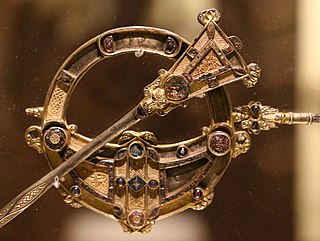
The Celtic brooch, more properly called the penannular brooch, and its closely related type, the pseudo-penannular brooch, are types of brooch clothes fasteners, often rather large; penannular means formed as an incomplete ring. They are especially associated with the beginning of the Early Medieval period in Ireland and Britain, although they are found in other times and places—for example, forming part of traditional female dress in areas in modern North Africa.

The Hunterston Brooch is a highly important Celtic brooch of "pseudo-penannular" type found near Hunterston, North Ayrshire, Scotland, in either, according to one account, 1826 by two men from West Kilbride, who were digging drains at the foot of Goldenberry Hill, or in 1830. It is now in the National Museum of Scotland, Edinburgh. Made within a few decades of 700 AD, the Hunterston Brooch is cast in silver, gilt, and set with pieces of amber, and decorated with interlaced animal bodies in gold filigree. The diameter of the ring is 12.2 cm, and in its centre there is a cross and a golden glory representing the risen Christ, surrounded by tiny bird heads. The pin, which is broken, can travel freely around the ring as far as the terminals, which was necessary for fastening; it is now 13.1 cm long, but was probably originally 15 cm or more.
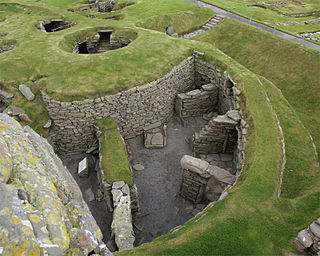
Prehistoric Shetland refers to the prehistoric period of the Shetland archipelago of Scotland, when it was first occupied by humans. The period prior to human settlement in Shetland is known as the geology of Scotland. Prehistory in Shetland does not end until the beginning of the Early Medieval Period in Scotland, around AD 600. More than 5,000 archaeological sites have been recorded in the Shetland Islands.

Art in Medieval Scotland includes all forms of artistic production within the modern borders of Scotland, between the fifth century and the adoption of the Renaissance in the early sixteenth century. In the early Middle Ages, there were distinct material cultures evident in the different federations and kingdoms within what is now Scotland. Pictish art was the only uniquely Scottish Medieval style; it can be seen in the extensive survival of carved stones, particularly in the north and east of the country, which hold a variety of recurring images and patterns. It can also be seen in elaborate metal work that largely survives in buried hoards. Irish-Scots art from the kingdom of Dál Riata suggests that it was one of the places, as a crossroads between cultures, where the Insular style developed.
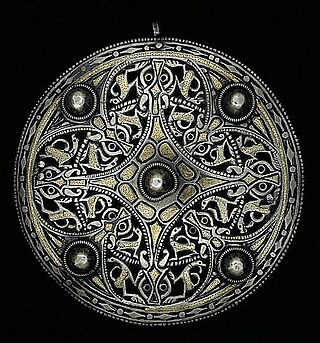
Trewhiddle style is a distinctive style in Anglo-Saxon art that takes its name from the Trewhiddle Hoard, discovered in Trewhiddle, Cornwall in 1770. Trewhiddle ornamentation includes the use of silver, niello inlay, and zoomorphic, plant and geometric designs, often interlaced and intricately carved into small panels. Famous examples include the Pentney Hoard, the Abingdon sword, the Fuller brooch, and the Strickland brooch.

Norrie's Law hoard is a sixth century silver hoard discovered in 1819 at a small mound in Largo, Fife, Scotland. Found by an unknown person or persons, most of the hoard was illegally sold or given away, and has disappeared. Remaining items of the hoard were found later at the mound, and were turned over to the landowner, General Philip Durham. The surviving 170 pieces from the hoard are now in the National Museum of Scotland. The treasure consists mostly of hacksilver and includes four complete silver pieces. Both Roman and much rarer Pictish objects are among the survivals.

The Breadalbane Brooch is a silver and gilt Celtic penannular brooch probably made in Ireland, but later altered and then found in Scotland. Probably dating to the 8th century, with 9th-century alterations, it is an intricately designed, silver-gilt dress fastener that is closely related to a select group of brooches that were produced in Ireland and Britain during the 'golden age' of late Celtic art. The brooch has been in the British Museum since 1919, and is normally on display.

The Bedale Hoard is a hoard of forty-eight silver and gold items dating from the late 9th to early 10th centuries AD and includes necklaces, arm-bands, a sword pommel, hacksilver and ingots. It was discovered on 22 May 2012 in a field near Bedale, North Yorkshire, by metal detectorists, and reported via the Portable Antiquities Scheme. Following a successful public funding campaign, the hoard was acquired by the Yorkshire Museum for £50,000.

Scottish jewellery is jewellery created in Scotland or in a style associated with Scotland, which today often takes the form of the Celtic style. It is often characterised by being inspired by nature, Scandinavian mythology, and Celtic knot patterns. Jewellery has a history in Scotland dating back to at least the Iron Age.
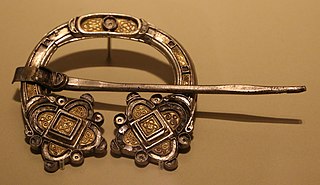
The Kilmainham Brooch is a late 8th- or early 9th-century Celtic brooch of the "penannular" type. With a diameter of 9.67 cm, it is a relatively large example, and is made from silver, gold and glass, with filigree and interlace decorations. Like other high-quality brooches of its class, it was probably intended to fasten copes and other vestments rather than for everyday wear, as its precious metal content would have made it a status symbol for its owner; less expensive Viking-style brooches were typically worn in pairs on women's clothing.

The Rogart Brooch is a large penannular brooch of Pictish origin, dated to the eighth century. Characteristic of contemporary Pictish brooches, it contains three-dimensional bird-head inserts formed with glass.

The Ballinderry Brooch is an Irish penannular brooch dated to the late 6th or early 7th centuries. It was found in the 1930s, along with a number of similar objects, underneath a timber floor of the late Bronze Age Ballinderry Crannóg No.2, on Ballinderry lake, County Offaly. Made from copper-alloy, tin and enamel, and decorated with millefiori patterns, it is relatively small, with a maximum ring diameter of 8.6 cm, while its pin is 18.3 cm long.





